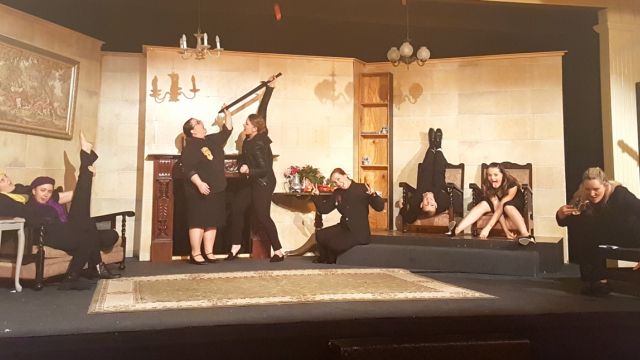Hamlet
Some 417 years after an all-male cast first performed Hamlet it’s been reimagined with an all-female ensemble. It sounded like an exciting proposition. Not only were all the roles played by women, the roughly four-hour script was cut down to a little over two hours long. Some scenes and characters were entirely removed and new dialogue and songs were added. The resulting script was one that heightened the feelings of Hamlet’s existential madness and did create a somewhat different narrative journey to the one with which you’d be familiar.
There’s always a danger of not matching audience expectations when performing such a well known play. Many directors feel the need to do something different with Shakespeare – to modernise, or interpret in an unexpected fashion. Many times it works rather well. This interpretation didn’t quite hit the mark, mostly due to the adapted passages and unfocussed directional vision.
The actors all gave it their best. They knew their lines and blocking and they worked very well together. Some were finding it hard to bring meaning to the Shakespearean language or to ascribe the right emotions to their dialogue. Others were finding it hard to muster genuine tears or anger when needed. Best acting on opening night was delivered by Ellen Hardisty as the Ghost and the Gravedigger. Bek Schmidt was lovely as Opelia; handling the slow decent into madness very well.
 The aforementioned direction of the play seemed somewhat confused and lacking focus. The set design predominantly featured a mixture of Edwardian and Victorian eras, making it hard to pin down the time setting. One can forgive such things assuming the producers may have been on a tight budget. When one character entered wearing a telephone headset, the chosen time period became even murkier. There was a Brechtian theme throughout of turning the house lights on and having the characters break the fourth wall – mostly during soliloquy. While all characters retained their original sex, for some unknown reason, ‘Polonia’ (originally Polonius) was turned into Ophelia’s ‘mother’.
The aforementioned direction of the play seemed somewhat confused and lacking focus. The set design predominantly featured a mixture of Edwardian and Victorian eras, making it hard to pin down the time setting. One can forgive such things assuming the producers may have been on a tight budget. When one character entered wearing a telephone headset, the chosen time period became even murkier. There was a Brechtian theme throughout of turning the house lights on and having the characters break the fourth wall – mostly during soliloquy. While all characters retained their original sex, for some unknown reason, ‘Polonia’ (originally Polonius) was turned into Ophelia’s ‘mother’.
The lighting, make-up and smoke effects for the ghost scenes were the best part of the production. It was fabulous to see King Hamlet’s ghost fighting against the chains trying to drag him back into the netherworld. It would have been preferable to have seen more of the beloved scenes from this play left as is instead of the insertion of many of the musical numbers. The cast, however, should be commended for their lovely voices. Their harmonies, especially when singing after Ophelia is buried were heavenly.
Conceptually speaking, modernising Hamlet, cutting it shorter, adding more songs and having an all-female cast are all great ideas. While this production wasn’t living up to expectations for this reviewer, those in the crowd less familiar with the original were overheard saying they enjoyed the show.
Kiesten McCauley
Subscribe to our E-Newsletter, buy our latest print edition or find a Performing Arts book at Book Nook.

